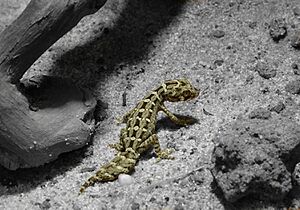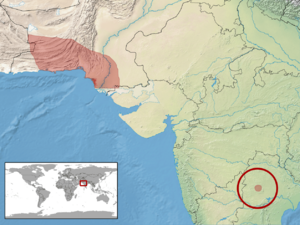Carrot-tail viper gecko facts for kids
Quick facts for kids Carrot-tail viper gecko |
|
|---|---|
 |
|
| Conservation status | |
| Scientific classification | |
 |
|
| Synonyms | |
|
Homonota fasciata Jerdon, 1854 |
The carrot-tail viper gecko (Hemidactylus imbricatus) is a unique type of gecko. It's known for its thick, carrot-shaped tail, which helps it store fat and water. These geckos are found in countries like Iran and Pakistan. There are also some old reports of them in India, but these are not fully confirmed.
Contents
About This Gecko
What Does It Look Like?
The carrot-tail viper gecko has a body that looks a bit flattened. Its legs are quite long and thin. The top of its head is covered with flat, many-sided scales.
Its back has large, diamond-shaped scales that are slightly bumpy. The scales on its belly are much smaller and smooth. The tail is thick and swollen, getting thinner towards the end. It's covered with overlapping, uneven scales. Some of the scales on the top of the tail are very large.
Colors and Patterns
This gecko is usually grayish in color. It has five brown stripes that run along its body. These stripes are broken up by white spots, which form bands across its body. You can often see about seven of these white bands on its neck and main body.
How Big Is It?
The head and body of a carrot-tail viper gecko are about 1.5 inches (38 mm) long. That's about the length of your thumb!
Naming the Gecko
Why Did Its Name Change?
Scientists give every animal a special two-part name, like Hemidactylus imbricatus. This helps everyone know exactly which animal they are talking about. This gecko used to be called Teratolepis fasciata.
However, scientists later realized that the group Teratolepis was actually part of a larger group called Hemidactylus. When they moved this gecko into the Hemidactylus group, its name would have become Hemidactylus fasciatus. But there was already another gecko with that exact name (Hemidactylus fasciatus Gray 1842)! To avoid confusion, scientists had to give our carrot-tail viper gecko a brand new name: Hemidactylus imbricatus.


